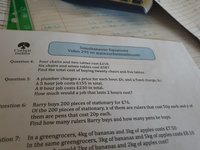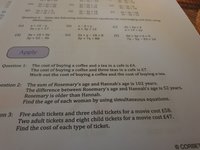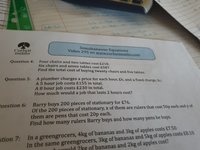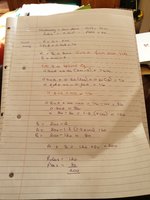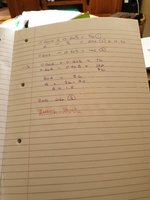You are using an out of date browser. It may not display this or other websites correctly.
You should upgrade or use an alternative browser.
You should upgrade or use an alternative browser.
Please can some help with worded Simulataneous Equations
- Thread starter mazph
- Start date
- Joined
- Nov 24, 2012
- Messages
- 3,021
Hello, and welcome to FMH! 
We are told that 200 pieces of stationary are bought. We also know that the sum of the number of rulers \(x\) and the number of pens \(y\) must be equal to this stated total. Based on this, can you state an equation in terms of \(x\) and \(y\)?
We are told that 200 pieces of stationary are bought. We also know that the sum of the number of rulers \(x\) and the number of pens \(y\) must be equal to this stated total. Based on this, can you state an equation in terms of \(x\) and \(y\)?
- Joined
- Nov 24, 2012
- Messages
- 3,021
I have tried I just cant do it.I have done the ones before and after .
If \(x\) is the number of rulers bought and \(y\) is the number of pens bought, and the total number of things bought (which includes only rulers and pens) is 200, then the sum of the number of rules bought and the numbers of pens bought must be 200. Can you state this as an equation?
- Joined
- Nov 24, 2012
- Messages
- 3,021
50x + 20y + 200 is this right but still stuck. This is the 1st time I have covered these questions.
thank you.
No, that's not an equation, and it doesn't relate to the total number of items. What we want is:
[MATH]x+y=200[/MATH]
This tells us that the number of rules bought plus the number of pens bought, which is the total number of things bought, is equal to 200, as the problem states.
Next we must deal with the total amount spent. We are told the total amount spend is 76 pounds, but the rules and pens are given in pence, and we need to use the same currency for both, so I would convert the total spent to 7600 pence. The total amount spent is the total amount spent on rules plus the total amount spent on pens. Can you now create the second equation?
Otis
Elite Member
- Joined
- Apr 22, 2015
- Messages
- 4,589
80 what? (We always report units, when answering story problems.)
Is it fair to say that you were able to answer #5 only because Denis gave you the equations to solve? That is, are you getting stuck because you're not sure how to convert English sentences into algebraic statements?
?
that might be the case I am 59 doing foundation maths don't know why someone asked me do it with them . the class is lots of resits and younger element, was shown / taught the Maths questions on monday but not the word questions. Out of the 7 question I just could not work out 5 and 6 because they seemed different and still not fully understanding. 6 is still a mystery. I am determined to get a 4. but have weaknesses. here is the full set of questions.
thank you any help is appreciated
thank you any help is appreciated
Attachments
50x + 20y + 200 is this right but still stuck. This is the 1st time I have covered these questions. thank you.
No, this is not at all correct. What you've written there is only an expression. Suppose Barry bought five rulers (i.e x = 5) and three pens (i.e. y= 3). Then we'd have 50(5) + 20(3) + 200 = 510... but what are we doing with this number? What does it mean? How does having the number 510 help us solve the problem?
Rather, let's return to the very basics. In my example where Barry bought five rulers and three pens, we know that he bought eight total pieces of stationary. But how did we know this? What operation did we use? Well, we used addition to deduce that Barry bought 5 + 3 = 8 total pieces of stationary. However, you're probably noticing a huge problem right about now. The problem specifically states that Barry bought 200 total pieces of stationary, so the solution of (5 rulers, 3 pens) is obviously not a valid one. But (100 rulers, 100 pens) would be, as would (25 rulers, 175 pens), (50 rulers, 150 pens), and so on...
Now, using the exact same line of reasoning and the exact same operation (addition), can you see that if Barry bought three pens and x rulers, he must have bought x + 3 total pieces of stationary? Similarly, if he bought five rulers and y pens, he must have bought 5 + y total pieces of stationary. Combining these two and letting both the number of rulers and number of pens be unknown variables, we see that Barry must have bought x + y pieces of stationary. Since the problem specifies that the total pieces of stationary is 200, what equation can you create?
At this point, we have one equation, but there's nothing more we can do with just this - in order to solve for two variables, we need two equations. So, what other information do we know, that might help us create another equation? We know how much each ruler costs and how much each pen costs. Can we do something with that? Suppose that Barry bought 125 rulers and 75 pens. Since each ruler costs 50p, we know he must have spent 6250p = £62.50 on rulers. Likewise, he must have spent 1500p = £15.00 on pens. But how did we know these values? What operation did we use? Well, we used multiplication to deduce that Barry spent 125 * 50p = 6250p on rulers and 75 * 20p = 1500p on pens. From there, we can use addition to find that the total amount spent is £62.50 + £15.00 = £77.50.
What would happen if we let the number of rulers be an unknown? If Barry bought x rulers, it only makes sense, using the exact same logic and exact same operation as before (multiplication), that he must have spent x * 50p on rulers. Likewise, if Barry bought y pens, he must have spent y * 20p on pens. How much, then, did he spend in total on stationary? Given that the problem specifies that Barry spent £76 = 7600p in total, what second equation can you create?
Given these two equations, it should be clear enough how to solve the resulting system and find out how many rulers and how many pens Barry bought. So give it a go and see what you come up with.
No, this is not at all correct. What you've written there is only an expression. Suppose Barry bought five rulers (i.e x = 5) and three pens (i.e. y= 3). Then we'd have 50(5) + 20(3) + 200 = 510... but what are we doing with this number? What does it mean? How does having the number 510 help us solve the problem?
Rather, let's return to the very basics. In my example where Barry bought five rulers and three pens, we know that he bought eight total pieces of stationary. But how did we know this? What operation did we use? Well, we used addition to deduce that Barry bought 5 + 3 = 8 total pieces of stationary. However, you're probably noticing a huge problem right about now. The problem specifically states that Barry bought 200 total pieces of stationary, so the solution of (5 rulers, 3 pens) is obviously not a valid one. But (100 rulers, 100 pens) would be, as would (25 rulers, 175 pens), (50 rulers, 150 pens), and so on...
Now, using the exact same line of reasoning and the exact same operation (addition), can you see that if Barry bought three pens and x rulers, he must have bought x + 3 total pieces of stationary? Similarly, if he bought five rulers and y pens, he must have bought 5 + y total pieces of stationary. Combining these two and letting both the number of rulers and number of pens be unknown variables, we see that Barry must have bought x + y pieces of stationary. Since the problem specifies that the total pieces of stationary is 200, what equation can you create?
At this point, we have one equation, but there's nothing more we can do with just this - in order to solve for two variables, we need two equations. So, what other information do we know, that might help us create another equation? We know how much each ruler costs and how much each pen costs. Can we do something with that? Suppose that Barry bought 125 rulers and 75 pens. Since each ruler costs 50p, we know he must have spent 6250p = £62.50 on rulers. Likewise, he must have spent 1500p = £15.00 on pens. But how did we know these values? What operation did we use? Well, we used multiplication to deduce that Barry spent 125 * 50p = 6250p on rulers and 75 * 20p = 1500p on pens. From there, we can use addition to find that the total amount spent is £62.50 + £15.00 = £77.50.
What would happen if we let the number of rulers be an unknown? If Barry bought x rulers, it only makes sense, using the exact same logic and exact same operation as before (multiplication), that he must have spent x * 50p on rulers. Likewise, if Barry bought y pens, he must have spent y * 20p on pens. How much, then, did he spend in total on stationary? Given that the problem specifies that Barry spent £76 = 7600p in total, what second equation can you create?
Given these two equations, it should be clear enough how to solve the resulting system and find out how many rulers and how many pens Barry bought. So give it a go and see what you come up with.
Thank you I will reread this tomorrow and have a go, because I need to master it. what level GCSE maths would this be.
Otis
Elite Member
- Joined
- Apr 22, 2015
- Messages
- 4,589
Here's an example exercise.
Denis bought 62 pencils. Some are premium pencils, and some are budget pencils.
Premium pencils cost $1.80 each, and budget pencils cost $0.05 each. Altogether, Denis paid $24.10 for his purchase.
How many premium pencils did Denis buy? How many budget pencils did Denis buy?
We're asked for two unknown numbers, so we assign symbols to represent them.
Let A = number of premium pencils
Let B = number of budget pencils
Now we can use symbols A and B, to write expressions and equations.
The expression A + B represents the total number of all pencils Denis bought. We know what that total is, from the given information. We write the first equation:
A + B = 62
That equation does not say anything about money. It only counts the pencils.
Next, we write an equation about the money. Each premium pencil costs $1.80, and Denis bought A of them, so the money paid for premium pencils is expressed as 1.80A. (If you have trouble understanding why the expression 1.80A represents money spent on premium pencils, let us know.) Likewise, 0.05B is the expression which represents the money paid for budget pencils. If we add these two amounts of money together, we get the total purchase amount. We know the total purchase amount, from the given information. We write the second equation:
1.80A + 0.05B = 24.10
Now, there are a number of ways to find the values of A and B. I'm not sure how you solved problem #5, so I will show the substitution method.
Solve the first equation for one of the variables, and then substitute the result for the same variable in the other equation. Doing that provides a new equation containing only one variable.
I choose to solve the first equation for B, and then I substitute the result for B in the second equation.
A + B = 62
Subtract A from each side
B = 62 - A
Substitute this result for B in the second equation
1.80A + 0.05(62 - A) = 24.10
See? This equation contains only one variable, so we can solve for it.
On the left-hand side, use the distributive property to multiply 0.05(62 - A)
1.80A + 0.05(62) + 0.05(-A) = 24.10
1.80A + 3.10 - 0.05A = 24.10
Combine the two like-terms
1.75A + 3.10 = 24.10
Isolate the A-term on the left, by subtracting 3.10 from each side
1.75A + 3.10 - 3.10 = 24.10 - 3.10
1.75A = 21
Divide each side by 1.75 to solve for A
1.75A / 1.75 = 21 / 1.75
A = 12
How do we find B? We use the formula for B that we already found (above).
B = 62 - A
B = 62 - 12
B = 50
So far, we think A = 12 and B = 50. Let's check those candidates (always a good idea), using our two equations.
A + B = 62
12 + 50 = 62
1.80A + 0.05B = 24.10
1.80(12) + 0.05(50) = 24.10
21.60 + 2.50 = 24.10
I hope this example helps you to write two equations and to find the solution, for problem #6. Cheers
?
Denis bought 62 pencils. Some are premium pencils, and some are budget pencils.
Premium pencils cost $1.80 each, and budget pencils cost $0.05 each. Altogether, Denis paid $24.10 for his purchase.
How many premium pencils did Denis buy? How many budget pencils did Denis buy?
We're asked for two unknown numbers, so we assign symbols to represent them.
Let A = number of premium pencils
Let B = number of budget pencils
Now we can use symbols A and B, to write expressions and equations.
The expression A + B represents the total number of all pencils Denis bought. We know what that total is, from the given information. We write the first equation:
A + B = 62
That equation does not say anything about money. It only counts the pencils.
Next, we write an equation about the money. Each premium pencil costs $1.80, and Denis bought A of them, so the money paid for premium pencils is expressed as 1.80A. (If you have trouble understanding why the expression 1.80A represents money spent on premium pencils, let us know.) Likewise, 0.05B is the expression which represents the money paid for budget pencils. If we add these two amounts of money together, we get the total purchase amount. We know the total purchase amount, from the given information. We write the second equation:
1.80A + 0.05B = 24.10
Now, there are a number of ways to find the values of A and B. I'm not sure how you solved problem #5, so I will show the substitution method.
Solve the first equation for one of the variables, and then substitute the result for the same variable in the other equation. Doing that provides a new equation containing only one variable.
I choose to solve the first equation for B, and then I substitute the result for B in the second equation.
A + B = 62
Subtract A from each side
B = 62 - A
Substitute this result for B in the second equation
1.80A + 0.05(62 - A) = 24.10
See? This equation contains only one variable, so we can solve for it.
On the left-hand side, use the distributive property to multiply 0.05(62 - A)
1.80A + 0.05(62) + 0.05(-A) = 24.10
1.80A + 3.10 - 0.05A = 24.10
Combine the two like-terms
1.75A + 3.10 = 24.10
Isolate the A-term on the left, by subtracting 3.10 from each side
1.75A + 3.10 - 3.10 = 24.10 - 3.10
1.75A = 21
Divide each side by 1.75 to solve for A
1.75A / 1.75 = 21 / 1.75
A = 12
How do we find B? We use the formula for B that we already found (above).
B = 62 - A
B = 62 - 12
B = 50
So far, we think A = 12 and B = 50. Let's check those candidates (always a good idea), using our two equations.
A + B = 62
12 + 50 = 62
1.80A + 0.05B = 24.10
1.80(12) + 0.05(50) = 24.10
21.60 + 2.50 = 24.10
I hope this example helps you to write two equations and to find the solution, for problem #6. Cheers
?
Last edited:
Otis I have done this using substitution, we have not been taught this for Simultaneous Equations,I have followed your method. I have tried the elimination method just getting stuck when I try to substitute back in. I have attached 2 photos.
Thank you for you help I do appreciate it.
Thank you for you help I do appreciate it.
Attachments
Otis
Elite Member
- Joined
- Apr 22, 2015
- Messages
- 4,589
Hi. No problem. (But you could have mentioned the method you're supposed to use, in your first post.)We have only been taught the elimination method …
Let's eliminate B, in my example system of two equations.
A + B = 62
1.80A + 0.05B = 24.10
The coefficients on B are 1 (in the first equation) and 0.05 (in the second equation). If we multiply the first equation by -0.05, then B can be eliminated, by adding equations as shown below.
(-0.05)(A + B) = (-0.05)(24.10)
-0.05A - 0.05B = -3.10
1.80A + 0.05B = 2410
------------------------
1.75A = 21
Solve for A
1.75A = 21/1.75
A = 50
B = 62 - 50 = 12
Same result. Let us know, if you have any questions about this. Otherwise, please show your work, if you need more help on your exercise. Cheers
?

